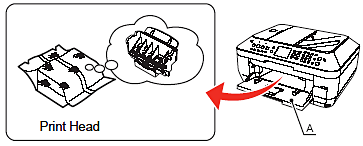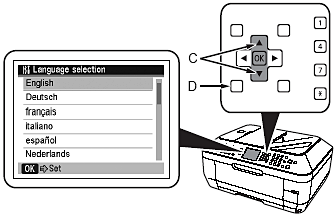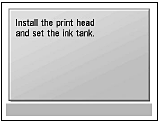Solution
Before turning on the machine, remove all the orange tapes and the protective sheets.
The Print Head is placed inside of the Paper Output Tray (A).
Open the Paper Output Tray with your hands, and take out the Print
- Manuals
- Setup CD-ROM (containing the drivers, applications and on-screen manuals)
- USB cable
- Warranty
IMPORTANT
- (A) BS Type: Use in the UK, Ireland and other countries where BS Type plugs are used.
- (B) EUR Type: Use in EU countries and other countries where EUR Type plugs are used.
Choosing a Location
IMPORTANT
- Do not install the machine where an object may fall on it. The object may fall inside the machine, resulting in malfunction.
- Do not place any object on top of the machine. It may fall into the machine when opening covers, resulting in malfunction.
Connect the Telephone Line
This section describes the basic method of telephone line connection.
To use the machine as a fax, a telephone line needs to be connected.
When not using as a fax: -> Go to "3 Turn the Power On"
When using as both a fax and telephone: -> 1. 2.
When using as a fax only: -> 1. only
1. Connect the machine with a telephone line
using the supplied telephone line cable (A).
When using as a fax only: -> Go to "Turn the Power On" .
IMPORTANT
- Users in Europe: If you prepare your own telephone line cable, be sure it is a 6-wire telephone line cable.
2. Only when connecting a telephone:
Remove the telephone connector cap (B), then connect a telephone with the telephone line cable.
IMPORTANT
- Do not connect the machine and a telephone in parallel to the same telephone line using a distribution adapter. The machine may not operate properly.
- Users in the UK: Use a B.T. adapter for connection as required.
1. Plug the power cord into the back left of the machine, then connect the other end to the wall outlet.
IMPORTANT
Do NOT connect the USB cable at this stage.
2. Turn on the machine (A).
IMPORTANT
- Make sure that the Document Cover (B) is closed.
NOTE
- The machine may make some operating noises. This is normal operation.
3.Use the

or

button (C) on the Operation Panel to select the language for the LCD, then press the OK button.
IMPORTANT
- If an unintended language is displayed on the LCD, press the Back button (D) to return to the Language selection screen.
4. Use the

or

button (C) on the Operation Panel to select the country or region of use, then press the OK button.
NOTE
The Country select screen may not be displayed depending on the country or region of purchase.
5.The standby screen is displayed.
IMPORTANT
Handle the Print Head carefully. Do not drop or apply excessive pressure to it.
1. Open the Paper Output Tray (A), then lift the Scanning Unit (Cover) (B) until it locks into place.
Close the Document Cover (C) and lift it with the Scanning Unit (Cover).
The Scanning Unit Support (D) is fixed automatically.
The Print Head Holder (E) comes out. (This is where you install the Print Head.)
IMPORTANT
- The Print Head Holder makes a noise as it moves. This is normal operation.
- If the Print Head Holder does not move, make sure that the machine is turned on.
2. Firmly raise the Print Head Lock Lever (F) until it stops.
IMPORTANT
The Print Head Lock Lever (F) may feel heavy.
3. Remove the Print Head from the silver package.
IMPORTANT
- There may be some transparent or light blue ink on the inside of the bag the Print Head comes in, or the inside of the protective cap - this has no effect on print quality. Be careful not to get ink on yourself when handling these items. Be careful not to stain your hands.
4. Remove the orange protective cap.
5. Tilt the Print Head forward and set it in place.
IMPORTANT
- Do not knock the Print Head against the sides of the holder.
- Install in a well-lit environment.
6. Lower the Print Head Lock Lever (F) completely.
IMPORTANT
- Pinch the Print Head Lock Lever firmly and lower it gently.
- Once you have installed the Print Head, do not remove it unnecessarily.
IMPORTANT
- Handle the ink tanks carefully. Do not drop or apply excessive pressure to them.
- If the Print Head Holder moves to the right, close and reopen the Scanning Unit (Cover).
- Be sure to use the supplied ink tanks.
1. Pull the orange tape (1) in the direction of the arrow to peel off the protective film and remove the film (2) completely.
2. While pressing down with your left thumb, twist off the orange protective cap(A) located on the bottom of the ink tank.
IMPORTANT
Do not hold the sides of the ink tank; ink may splash.
3. Install the ink tank
Insert the ink tank fully into the Print Head.
4. Press the PUSH mark on the ink tank until it clicks into place.
Make sure the Ink lamp lights red.
5. Install all the other ink tanks in the same way.
Make sure all the Ink lamps light red.
Install all the ink tanks.
IMPORTANT
- Install in a well-lit environment.
- Match the labels when installing.
- Once you have installed the ink tanks, do not remove them unnecessarily.
6. Lift the Scanning Unit (Cover) (B) slightly and fold the Scanning Unit Support (C), then gently close the Scanning Unit (Cover) (B).
- Wait until the screen above appears (about 4 minutes) and go to the next step.
- The machine may make some operating noises when preparing to print. This is normal operation.
IMPORTANT
If an error message is displayed on the LCD, make sure that the Print Head and the ink tanks are correctly installed.
7. Load three or more sheets of A4 or Letter-sized plain paper into the Cassette (D), then press the OK button.
NOTE
- For details, refer to "Loading Paper".
- Close the Paper Output Tray to make it easier to pull out the Cassette.
8. Press the OK button.
The standby screen is displayed.
IMPORTANT
- For better print results, it is recommended that you align the Print Head before
printing photos. To align the Print Head, use the

or

button to select Perform head align and press the OK button. Follow the steps in "Align the Print Head".
Select a receive mode according to your needs to receive faxes easily.
- When using as a fax only:
When you want to receive only faxes (FAX only mode)
When a call arrives:
Voice call: You cannot answer the call.
Fax call: The machine does not ring.
Faxes are received automatically.
- When using as both a fax and telephone:
When you receive more voice calls than faxes (TEL priority mode)
When a call arrives:
Voice call: Pick up the handset to answer the call.
Fax call: If you pick up the handset and hear the fax tone, the machine will switch to the fax automatically and receive the fax.
If you use Distinctive Ring Pattern Detection (DRPD) service
When a call arrives:
Voice call: The telephone continues to ring.
Pick up the handset to answer the call.
Fax call: Faxes are received automatically
when the machine detects the fax ring pattern.
NOTE
- When a telephone is connected to the machine, the telephone rings for incoming calls depending on the selected mode.
1. Press the FAX button (A), then press the Menu button (B).
The FAX menu screen is displayed.
2. Press the OK button.
The Receive mode settings screen is displayed.
3. Use the

or

button (C) to select a receive
mode, then press the OK button. When the FAX menu returns, press the Back button (D).
The selected receive mode is displayed.
This section explains how to load paper in the Cassette (A) and the Rear Tray (B).
The Cassette (A) supports plain paper (C) only.
To print photo paper / Hagaki (D), be sure to load it in the Rear Tray (B).
1. Load in the Cassette
Pull out the Cassette (A).
2. Move the Paper Guides (E) and (F) to both edges.
3. Load paper with the printing side facing down.
Load paper.
4. Slide the Paper Guide (E) to align with the mark of paper size.
The Paper Guide (E) will stop when it aligns with the corresponding mark of paper size.
NOTE
There may be a little space between the Paper Guide (E) and the paper stack.
5. Slide the Paper Guide (F) against left edge of the paper.
Confirm that the loaded paper does not exceed the line (G).
IMPORTANT
To print on specialty paper, be sure to load it in the Rear Tray.
6. Insert the Cassette (A) into the machine until it clicks into place.
7. Load paper in the Rear Tray
Open the Paper Support (H) and pull it out.
8. Move the Paper Guides (I) to both edges.
9. Load paper in portrait orientation with the printing side facing up.
Load paper in the center of the Rear Tray.
10. Slide the left and right Paper Guides (I) against both edges of the paper.
Confirm that the loaded paper does not exceed the line (J).
NOTE
For details on media sizes and types you can use, refer to
Loading Paper.
Align the Print Head for better print results.
To cancel printing the alignment pattern, press the Stop button (A).
Use three sheets of A4 or Letter-sized plain paper for alignment.
1. Confirm that three or more sheets of A4 or Letter-sized plain paper are loaded into the Cassette (B).
NOTE
For details, refer to "Loading Paper".
2. Select Yes, then press OK button. Printing of the first pattern starts.
NOTE
Make sure that the Output Tray Extension (C) is extended.
3. When the above pattern is printed, select Yes and press the OK button.
NOTE
The pattern is printed in black and blue.
4. Look at the first printout, and use the

buttons to enter the number of the pattern that has the least noticeable vertical or horizontal streaks for columns A to G, then press the OK button.
NOTE
If it is difficult to pick the best pattern, pick the setting that produces the least noticeable white streaks.
5. Confirm the above message, then press the OK button.
Printing of the second pattern starts.
6. Follow the same procedure as step 4. to enter the number of the pattern that has the least noticeable vertical streaks for columns H to Q, then press the OK button.
7. Confirm the above message, then press the OK button.
Printing of the third pattern starts.
8. Enter the number of the pattern that has the least noticeable horizontal stripes for columns a to j, then press OK button.
NOTE
If it is difficult to pick the best pattern, pick the setting that produces the least noticeable white stripes.
9. The standby screen is displayed.
Print Head Alignment is now complete.







 or
or  button (C) on the Operation Panel to select the language for the LCD, then press the OK button.
button (C) on the Operation Panel to select the language for the LCD, then press the OK button.
 or
or  button (C) on the Operation Panel to select the country or region of use, then press the OK button.
button (C) on the Operation Panel to select the country or region of use, then press the OK button.


















 or
or  button to select Perform head align and press the OK button. Follow the steps in "Align the Print Head".
button to select Perform head align and press the OK button. Follow the steps in "Align the Print Head".

 or
or  button (C) to select a receive
button (C) to select a receive















 buttons to enter the number of the pattern that has the least noticeable vertical or horizontal streaks for columns A to G, then press the OK button.
buttons to enter the number of the pattern that has the least noticeable vertical or horizontal streaks for columns A to G, then press the OK button.




